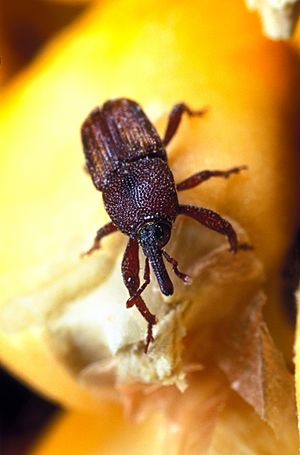Maize weevil facts for kids
Quick facts for kids Maize weevil |
|
|---|---|
 |
|
| Scientific classification | |
| Kingdom: | |
| Phylum: | |
| Class: | |
| Order: | |
| Family: | |
| Genus: | |
| Species: |
S. zeamais
|
| Binomial name | |
| Sitophilus zeamais (Motschulsky), 1855
|
|
The maize weevil (Sitophilus zeamais) is a type of beetle from the weevil family. In the United States, it is sometimes called the greater rice weevil. This small beetle lives in many warm, tropical places around the world. It is a big pest for maize (corn) crops.
Maize weevils attack crops that are still growing in the field. They also attack crops after they have been harvested and stored. They can damage wheat, rice, sorghum, oats, barley, rye, buckwheat, peas, and even cottonseed. These weevils also eat processed cereal foods like pasta and cassava. Sometimes, they even attack fruits like apples while they are in storage.
Contents
What it Looks Like
The maize weevil is a close relative of the rice weevil. It is a small, brown beetle, usually about 2.5 to 4 millimeters long. That's about the size of a few grains of sand! It has four reddish-brown spots on its wing covers, which are called elytra. The weevil also has a long, thin snout and bent antennae.
The maize weevil looks a lot like the rice weevil (Sitophilus oryzae). However, the maize weevil usually has clearer spots on its wings. It is also a bit bigger than the rice weevil. Unlike some other weevils, the maize weevil can fly.
Where it Lives
The maize weevil is found in warm, wet parts of the world. It especially likes places where maize (corn) is grown. You can find it in places like Polynesia, Argentina, Brazil, Burma, Cambodia, Greece, Japan, Morocco, Spain, Syria, Turkey, and the United States. It is also common in northern Australia and parts of Sub-Saharan Africa.
Sometimes, maize weevils are found in Canada, in provinces like Ontario and Quebec. They might arrive there on ships carrying grain. However, they usually don't stay and grow in Canada because it's too cold. But they have been found in Montreal where grain from the U.S. is stored.
Life Cycle
The maize weevil goes through its whole life cycle in about 36 days. It starts when a female weevil chews a small hole in a grain of corn or another seed. She then lays a tiny, oval, white egg inside the hole. After laying the egg, she covers the hole with a waxy plug. This plug hardens and leaves a small raised bump on the seed. This bump is often the only sign that an egg is inside. Only one egg is laid in each grain.
When the egg hatches, a white, legless grub (larva) comes out. This grub stays inside the grain and eats it. The grub then changes into a pupa while still inside the grain. Finally, the pupa changes into an adult beetle. The adult beetle chews a round hole in the grain and comes out.
A single female weevil can lay between 300 and 400 eggs in her lifetime. Adult weevils can live for 5 to 8 months. For them to breed, the temperature needs to be between 15 and 34 degrees Celsius. They also need at least 40% humidity in the air.
When adult weevils come out, the females go to a high spot. They then release special chemicals called pheromones. These pheromones attract the male weevils for mating.
What it Eats
The maize weevil often attacks crops while they are still growing, especially maize before it's harvested. It is also commonly found on rice. It can infest raw or processed grains like wheat, oats, barley, sorghum, rye, and buckwheat.
This weevil can breed in crops with a wider range of moisture levels than the rice weevil. It has even been found in fruits like apples that are being stored. While maize weevils usually can't breed easily in very finely processed grains, they can breed in foods like macaroni and noodles if these foods get too much moisture.
Damage and How to Spot It
It can be hard to tell if maize weevils are present early on. This is because the young weevils (larvae) eat the inside of the grains. They often leave only the outer shell. You might see a flour-like dust mixed with tiny insect waste (called frass).
If grains are infested, you will see small holes where the adult beetles have chewed their way out. One way to check for infestation is to put the grains in water. If many grains float to the surface, it might mean they are hollowed out by weevils. Ragged holes in individual grains, similar to damage from rice weevils, also suggest an infestation.
In large piles of stored grain, you might notice the temperature going up. This can be a sign of many weevils eating and moving around. The easiest way to know for sure is when you start seeing adult weevils crawling around.
Images for kids
See also
 In Spanish: Gorgojo del maíz para niños
In Spanish: Gorgojo del maíz para niños


